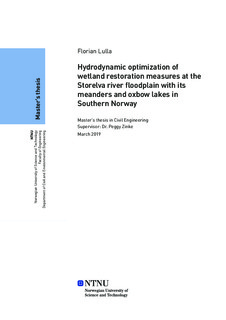| dc.description.abstract | The “Fellesprosjektet Ringeriksbanen og E16” is an infrastructure project in the south of Norway connecting Oslo and shortening the travel time with the new housing and develop-ment area of Ringerike. For the connection of Sundvollen and Hønefoss the FRE16 project is planned to cross the river Storelva and its neighboring wetlands. The area under investigation is partly defined as a Ramsar conservation area and important to many wildlife and vegetation species.
The planning institution has provided two alternatives for the crossing of the river Storelva and the wetland Mælingen north of the main channel. Alternative A, a bridge over Mælingen and Alternative B, a bridge with a partly dam over Mælingen were investigated for the flood event of 1967 with a numerical 2D unsteady flow model with HEC-RAS 5.0.6 and compared with the actual condition of the Storelva area. Furthermore the statistical flood events HQ10 and HQ200 were implemented into the 2D model for Alternative B and the actual condition and analyzed. As a comparison of the influence of the regulation of the Storelva, the statistical 0.9 percentile of an annual flood over two periods, before and after the regulation, were calculated and the results are presented. For the future restoration of the oxbow lakes one calculation was made with a deepened bed to 58.3 m above-normal in the oxbow lakes Juveren and Synneren and the flow hydrograph for HQ200. The numerical model was calibrated and validated and inaccuracies in the existent bathymetry files were modified and technical objects implemented.
The results of the numerical model for Alternative B show a decrease of the water levels in the oxbow lakes Juveren and Synneren for a statistical flood event HQ10 of maximum 11 cm. For the flood events of 1967 and HQ200 however, the water surface elevation increases in the investigated oxbow lakes by 5 cm for the 1967 flood event and 1 cm for the HQ200 statistical flood. Nevertheless, the values of the water surface elevation results are smaller than the overall vertical resolution of the underlying terrain data with 25 cm and this accuracy has to be taken into account. The investigating of the velocities at the wetland Mælingen showed a decrease of the flow velocities at the Mælingen cross section for the statistical flood HQ10 and an increase of the velocities for the 1967 flood event and the HQ200 flood by twice the values of the actual condition.
For the ecological restoration it is recommended to implement a best management practice to reduce the inflow of non-point sources into the oxbow lakes. These methods have to be planned for each oxbow lake and managed to match the ecological needs of the conservation area. Furthermore the removal of Canadian pondweed should be considered and strategies for the measures should be undertaken. | |
